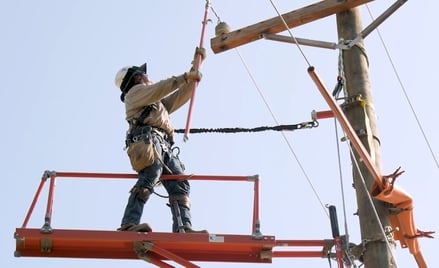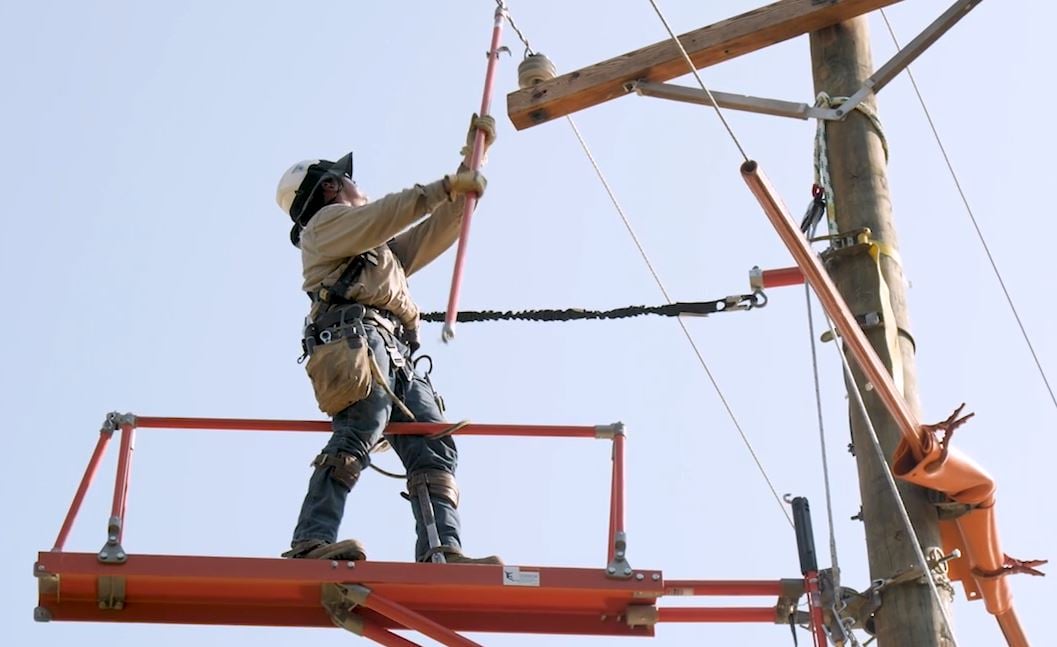
Energized line maintenance is a popular option for working on power lines. Two common methods for hot work include rubber gloving and hotsticking. These two work methods will utilize both primary and secondary levels of protection from energized lines and equipment. Live line barehand is another work method for working on energized lines and equipment but will not be discussed in this blog. This blog will discuss the differences between primary and secondary protection while using the rubber gloving or hotsticking work methods.
Primary Protection
In order to work on energized line equipment, using the hotsticking or rubber gloving method, a hotstick or pair of rubber insulating gloves must be used to encroach on the minimum approach distance (MAD) of the energized equipment. For OSHA qualified electrical workers, MAD is made up of two components, the minimum air insulating distance (MAID) and an ergonomic portion. For voltages of 301V – 750V the ergonomic portion is 1ft., for 751V - 72.5kV the ergonomic portion is 2ft., and for 72.6kV – 800kV the ergonomic portion is 1ft. The MAID distance is dependent on many factors including the system voltage, altitude, and transient overvoltages. OSHA 1910.269 provides more information on MAD distances in Tables R-3 through R-9. A link to these tables can be found at OSHA 1910.269 . For OSHA non-qualified electrical workers, the MAD distance is 10ft for up to 50kV. If greater than 50kV, the clearance increases by 4in. per each additional 10kV. (Note: Your utility may have more stringent MAD requirements.)
Per OSHA 1910.957 and 1910.137, the hotsticks and rubber insulating gloves used as primary protection must be designed, tested and manufactured to ASTM standards F711 and D120. The hotstick being used must have enough insulation to meet the MAD distance of the energized system. Often, a hand guard is installed on a hotstick to indicate how closely a worker can get to the energized lines and equipment. Per OSHA 1910.269(I)(3)(iii), rubber insulating gloves can be used to encroach on the MAD distance under certain conditions laid out in 1910.269(I)(3)(iii)(A). Leather protectors manufactured to ASTM F696 standard must be worn over the rubber gloves for mechanical protection. ASTM standards for both hotsticks and rubber gloves include a maximum leakage current requirement during electrical testing. CHANCE® 100% electrically tests hotsticks and rubber insulating gloves per ASTM F711 and D120 standards. Both products will also include a date stamp indicating when the electrical testing occurred. Once in service, OSHA requires rubber insulating gloves to be electrically retested at least every 6 months and hotsticks every 2 years. These products should also be removed from service, if during visual inspection before use, they are found to be damaged. (Note: Your employer may have more stringent testing requirements.)
Secondary Protection
When performing energized line maintenance, it may be necessary for line workers to install insulating cover-up or use insulating sleeves. Cover-up and rubber insulating sleeves can reduce the opportunity for secondary points of contact with energized lines or equipment. OSHA 1910.137 requires cover-up equipment, such as hard plastic covers, line hose, blankets, and misc. rubber covers to be designed, manufactured, and tested per ASTM F712, D1048, D1049, and D1050 standards. Secondary protection equipment does not have a maximum leakage current requirement during electrical testing. All secondary protection equipment is only intended for incidental brush contact per OSHA 1910.137(b)(2)(ii) Note 1. Primary protection equipment such as hotsticks and rubber insulating gloves must be used to install the cover-up. Once installed, the cover-up allows OSHA qualified electrical workers to encroach on the MAD of the energized lines or equipment. Per OSHA and ASTM, the only secondary protection that requires periodical electrical retesting when in use is rubber insulating blankets and sleeves. The maximum test interval is every 12 months. Secondary protection equipment should also be removed from service if, during visual inspection before use, they are found to be damaged. (Note: Your employer may have more stringent testing requirements.)
Choosing the Right Protection For Your Work Method
Primary and secondary personal protective equipment provides a level of protection from electrical shock due to contact with energized lines or equipment. Primary protection can only be provided by rubber insulating gloves and hotsticks. These products have design standards with maximum leakage current requirements and are recognized by OSHA as primary protection. They also have OSHA mandated routine testing requirements. Secondary protection products are only intended to be used for incidental brush contact. Please make sure to always follow the work practices and procedures of your employer.

